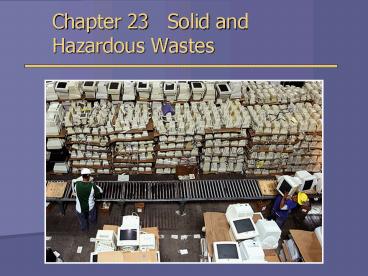Chapter 23 Solid and Hazardous Wastes - PowerPoint PPT Presentation
1 / 32
Title:
Chapter 23 Solid and Hazardous Wastes
Description:
Chapter 23 Solid and Hazardous Wastes * * * * * * * * * * * * * * * * * * * * * * * * * * * * * * * * Overview of Chapter 23 Solid Waste Waste Prevention Reducing the ... – PowerPoint PPT presentation
Number of Views:479
Avg rating:3.0/5.0
Title: Chapter 23 Solid and Hazardous Wastes
1
Chapter 23 Solid and Hazardous Wastes
2
Overview of Chapter 23
- Solid Waste
- Waste Prevention
- Reducing the Amount of Waste
- Reusing Products
- Recycling Materials
- Hazardous Waste
- Types of Hazardous Waste
- Management of Hazardous Waste
3
Solid Waste
- US generates more solid waste per capita than any
other country - 2.1 kg per person per day
4
Types of Solid Waste
- Municipal solid waste
- Solid material discarded by homes, office
buildings, retail stores, schools, etc. - Relatively small portion of solid waste produced
- Non-municipal solid waste
- Solid waste generated by industry, agriculture,
and mining
5
Composition of Municipal Solid Waste
6
Disposal of Solid Waste
- Three methods
- Sanitary Landfills
- Incineration
- Recycling
7
Sanitary Landfill
8
Sanitary Landfill
- Compacting and burying waste under a shallow
layer of soil - Most common method of disposal
- Problems
- Methane gas production by microorganisms
- Contamination of surface water ground water by
leachate - Not a long-term remedy
- Few new facilities being opened
- Closing a full landfill is very expensive
9
Sanitary Landfill
- Special Problem Plastic
- Much of plastic is from packaging
- Chemically stable and do not readily break down
and decompose
- Special Problem Tires
- Made from materials that cannot be recycled
- Can be incinerated or shredded
10
Incineration
- Volume of solid waste reduced by 90
- Produces heat that can make steam to generate
electricity - Produce less carbon emissions than fossil fuel
power plants - Byproduct
- Bottom ash
- Fly ash
11
Incineration
- Types of Incinerators
- Mass burn (below)
- Modular
- Refuse-derived
12
Composting
- Municipal Solid Waste Composting
- Includes Food scraps, Sewage sludge,
Agricultural manure, Yard waste - Reduces yard waste in landfills
- Can be sold or distributed to community
13
Waste Prevention
- Three Goals
- (1) Reduce the amount of waste
- (2) Reuse products
- (3) Recycle materials
14
Reducing Waste
- Purchase products with less packaging
15
Reducing Waste
- Source reduction
- Products designed and manufactured to decrease
the volume of solid waste - Pollution Prevention Act (1990)
- Dematerialization
- Progressive decrease in the size and weight of a
product as a result of technological improvements
16
Reusing Products
- Refilling glass beverage bottles
- Heavier glass that costs more
- Japan recycles almost all bottles
- Reused 20 times
17
Recycling Materials
- Every ton of recycled paper saves
- 17 trees
- 7000 gallons of water
- 4100 kwatt-hrs of energy
- 3 cubic yards of landfill space
- Recycle
- Glass bottles, newspapers, steel cans, plastic
bottles, cardboard, office paper
18
Recycling
- Recycling Paper
- US recycles 50
- Many developed countries are higher
- Recycling Glass
- US recycles 25
- Costs less than new glass (right)
19
Recycling
- Recycling Aluminum
- Making new can from recycled one costs far less
than making a brand new one - 49 of aluminum was recycled in 2007
- Recycling Metals other than Aluminum
- Lead, gold, iron, steel, silver and zinc
- Metallic composition is often unknown
- Makes recycling difficult
20
Recycling
- Recycling Plastic
- 12 of all plastic was recycled in 2007
- Less expensive to make from raw materials
- 37 of PET was recycled in 2007
- Mostly water and soda bottles
21
Recycling
- Recycling Tires
- Few products are made from old tires
- Playground equipment
- Trashcans
- Garden hose
- Carpet
- Roofing materials
- 36 of tires are currently recycled to make other
products
22
Integrated Waste Management
23
Hazardous Waste
- Any discarded chemical that threatens human
health or the environment - Reactive, corrosive, explosive or toxic chemicals
- Types of Hazardous Waste
- Dioxins
- PCBs
- Radioactive waste
Love Canal Toxic Waste Site
24
Hazardous Waste
25
Case-In-Point Hanford Nuclear Reservation
26
Management of Hazardous Waste
- Chemical accidents
- National Response Center notified
- Typically involves oil, gasoline or other
petroleum spill - Current Management Policies
- Resource Conservation and Recovery Act (1976,
1984) - Comprehensive Environmental Response,
Compensation, and Liability Act (1980) - Commonly known as Superfund
27
Superfund Program
- Cleaning up existing hazardous waste
- 400,000 waste sites
- Leaking chemical storage tanks and drums (right)
- Pesticides dumps
- Piles of mining wastes
- Must be cleaned up
28
Management of Hazardous Waste
- Superfund National Priorities List
- 2009 1,264 sites on the list
- States with the greatest number of sites
- New Jersey (114)
- California (94)
- Pennsylvania (94)
- New York (85)
- Michigan (65)
29
Management of Hazardous Waste
- Biological Treatment of Hazardous Chemicals
- Bioremediation - use of bacteria and other
microorganisms to break down hazardous waste into
relatively harmless products - Time consuming
- Phytoremediation - use of plants to absorb and
accumulate hazardous materials in the soil - Ex Indian mustard removed heavy metals
30
Examples of Phytoremediation
31
Management of Hazardous Waste
- (1) Source reduction
- (2) Conversion to less hazardous materials
- (3) Long-term storage
32
Hazardous Waste Landfill































